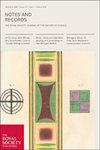以查尔斯·达尔文在火地岛的活动为例,探讨分析19世纪科学与帝国收藏之旅的方法
IF 0.6
3区 哲学
Q3 HISTORY & PHILOSOPHY OF SCIENCE
Notes and Records-The Royal Society Journal of the History of Science
Pub Date : 2018-08-29
DOI:10.1098/rsnr.2018.0012
引用次数: 1
摘要
查尔斯·达尔文(Charles Darwin)和阿尔弗雷德·拉塞尔·华莱士(Alfred Russel Wallace)对自然历史和进化的兴趣使他们前往地球上遥远的地方,进行危险的、多感官的旅行,最终目的是为了收集。本文介绍了一种以历史地理学、人类学、文本分析和地理人文科学为基础,更详细地探索这些复杂经验的方法。它包括寻找证据,证明他们在收集和连接数据、观察、图像、标本、记忆和想法的过程中,有着丰富的刺激和经常具有挑战性的感官动态。达尔文在火地岛的功绩作为一个案例研究,特别关注1833年“火地岛”人体颜料的收藏。这种类型的分析为在收集过程中与人和地点相遇的多感官纠缠提供了新的视角。它帮助我们更好地理解那些塑造了被收集和带回英国的东西的经历,以及与这些收藏相关的个人观察,这些观察为达尔文关于物种起源的工作播下了种子。本文章由计算机程序翻译,如有差异,请以英文原文为准。
Towards a methodology for analysing nineteenth-century collecting journeys of science and empire, with Charles Darwin's activities in Tierra del Fuego as a case study
The interests of Charles Darwin and Alfred Russel Wallace in natural history and evolution took them to remote parts of the globe on hazardous, multi-sensory journeys that were ultimately about collecting. This paper introduces a methodology for exploring these complex experiences in more detail, informed by historical geography, anthropology, textual analysis and the geo-humanities. It involves looking for evidence of the richly stimulating and often challenging sensory dynamics within which they collected and connected data, observations, images, specimens, memories and ideas. Darwin's exploits in Tierra del Fuego are examined as a case study, with a particular focus on the collection of ‘Fuegian’ body paints in 1833. This type of analysis provides a fresh insight into the multi-sensory entanglement of encounter with people and place involved in the collecting process. It helps us to understand better the experiences that shaped what was collected and brought back to Britain, and the personal observations associated with these collections that sowed the seeds for Darwin's work on the origin of species.
求助全文
通过发布文献求助,成功后即可免费获取论文全文。
去求助
来源期刊
CiteScore
1.50
自引率
0.00%
发文量
45
审稿时长
>12 weeks
期刊介绍:
Notes and Records is an international journal which publishes original research in the history of science, technology and medicine.
In addition to publishing peer-reviewed research articles in all areas of the history of science, technology and medicine, Notes and Records welcomes other forms of contribution including: research notes elucidating recent archival discoveries (in the collections of the Royal Society and elsewhere); news of research projects and online and other resources of interest to historians; essay reviews, on material relating primarily to the history of the Royal Society; and recollections or autobiographical accounts written by Fellows and others recording important moments in science from the recent past.

 求助内容:
求助内容: 应助结果提醒方式:
应助结果提醒方式:


